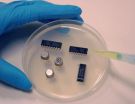(Press-News.org) Genetically modified cells can be made to communicate with each other as if they were electronic circuits. Using yeast cells, a group of researchers at the University of Gothenburg, Sweden, has taken a groundbreaking step towards being able to build complex systems in the future where the body's own cells help to keep us healthy. The study was presented recently in an article in the scientific journal Nature.
"Even though engineered cells can't do the same job as a real computer, our study paves the way for building complex constructions from these cells," says Kentaro Furukawa at the University of Gothenburg's Department of Cell- and Molecular Biology, one of the researchers behind the study. "In the future we expect that it will be possible to use similar cell-to-cell communication systems in the human body to detect changes in the state of health, to help fight illness at an early stage, or to act as biosensors to detect pollutants in connection with our ability to break down toxic substances in the environment."
Combining biology and technology
Synthetic biology is a relatively new area of research. One application is the design of biological systems that are not found in nature. For example, researchers have successfully constructed a number of different artificial connections within genetically modified cells, such as circuit breakers, oscillators and sensors.
Some of these artificial networks could be used for industrial or medical applications. Despite the huge potential for these artificial connections, there have been many technical limitations to date, mainly because the artificial systems in individual cells rarely work as expected, which has a major impact on the results.
Biotechnology challenges the world of computers
Using yeast cells, the research team at the University of Gothenburg has now produced synthetic circuits based on gene-regulated communication between cells. The yeast cells have been modified genetically so that they sense their surroundings on the basis of set criteria and then send signals to other yeast cells by secreting molecules. The various cells can thus be combined like bricks of Lego to produce more complicated circuits. Using a construction of yeast cells with different genetic modifications, it is possible to carry out more complicated "electronic" functions than would be the case with just one type of cells.
The University of Gothenburg research team is headed by professor Stefan Hohmann, and also comprises Kentaro Furukawa and Jimmy Kjellén.
The article Distributed biological computation with multicellular engineered networks, published in the scientific journal Nature on 8 December, was the result of a partnership with two Spanish research teams at Universitat Pompeu Fabra in Barcelona. The work forms part of the EU CELLCOMPUT project.
Researchers open the door to biological computers
2010-12-15
ELSE PRESS RELEASES FROM THIS DATE:
A positive step in the face of uncertainty
2010-12-15
TEMPE, Ariz. – Enormous uncertainty. These two words describe the condition of Phoenix's climate and water supply in the 21st century. Reservoirs have dipped to their lowest levels, continuous drought has plagued the state and forecasts for even warmer summers are predicted. Despite this uncertainty, professors at Arizona State University say there's no need to be fearful because positive impacts can be made.
ASU professors Patricia Gober and Craig Kirkwood working in conjunction with Decision Center for a Desert City (DCDC), which specializes in decision making under ...
UCI researchers find novel memory-enhancing mechanism in brain
2010-12-15
Irvine, Calif., Dec. 14, 2010 — UC Irvine researchers have identified a novel mechanism in the brain that boosts memory.
In collaboration with scientists at Germany's University of Munster, the UCI team found that a small protein called neuropeptide S can strengthen and prolong memories of everything from negative events to simple objects.
According to study leader Rainer Reinscheid, UCI associate professor of pharmaceutical sciences, the discovery could provide important clues about how the brain stores memories and also lead to new treatments for Alzheimer's disease, ...
It's time for a new approach to Alzheimer's disease
2010-12-15
NEW BRUNSWICK, N.J. – Karl Herrup thinks that the national research effort to understand Alzheimer’s disease has gone about as far as it can go with its current theories. And that’s not far enough.
Alzheimer's disease is an incurable, degenerative, eventually fatal disease that attacks cognitive function. It affects more than 26 million people around the world and is the most common form of dementia among people over the age of 65. Over the last three decades, most Alzheimer’s research has been governed by the “amyloid cascade hypothesis.” The theory – which holds that ...
People who believe in justice also see a victim's life as more meaningful after tragedy
2010-12-15
Seeing bad things happen to other people is scary. One way to respond to this is to blame the victim—to look for some reason why it happened to them. But there's another common response, according to a new study published in Psychological Science, a journal of the Association for Psychological Science. The researchers found that people who believe in justice in the world also believe that a tragedy gives the victim's life more meaning.
"A lot of the time when people see someone else suffering, and helping them isn't an option, people will instead justify the fact that ...
Rationalization measures are the main cause of poor work environment
2010-12-15
Managers in the private and public sectors must consider work environment when rationalising production to obtain sustainable systems. A research study published in the journal Applied Ergonomics reveals that rationalisation measures often have a major negative impact on both the physical and psychosocial work environment. "However, the review also presents scientific evidence on how to reduce this problem," says one of the researchers, at the University of Gothenburg.
"Considerable resources all over the world have been invested in dealing with work-related disorders. ...
Anatomy of a shopping spree: Pretty things make us buy more
2010-12-15
Chestnut Hill, Mass. (Dec. 14, 2010) – With the holidays fast approaching and consumers in full shopping mode, new research shows that a seemingly innocent luxury item purchase can lead to an unintended, budget-busting spending spree.
The problem starts with the purchase of a new item, particularly those among designer product lines, luxury branded items, or consumer goods of high-end design. Once home, these items – graced with what researchers call salient design elements, such as a unique pattern or interesting color scheme – can look out of place when compared to ...
Study shows post-9/11 security zones blight landscape
2010-12-15
DENVER (Dec. 14, 2010) – A decade after the 9/11 attacks, significant parts of America's most prominent downtowns remain largely sealed off as `security zones,' but a newly published study by University of Colorado Denver professor Jeremy Németh says this has led to blighted landscapes, limited public access and a need for a new approach to urban planning.
"Our most open, public cities are becoming police states," said Németh, assistant professor of planning and design whose study was recently published in Environment and Planning A. "While a certain amount of security ...
Cell of origin for brain tumors may predict response to therapy
2010-12-15
For patients with glioma, the most common primary brain tumor, new findings may explain why current therapies fail to eradicate the cancer. A UCSF-led team of scientists has identified for the first time that progenitor rather than neural stem cells underly a type of glioma called oligodendroglioma. This distinction explains why oligodendroglioma is more responsive to therapy than other brain tumors such as glioblastoma multiforme.
The finding is significant, the researchers say, because it gives cancer doctors and researchers new cellular pathways to target in developing ...
Once upon a time in the Intensive Care Unit ...
2010-12-15
MONTREAL, December 14, 2010 – The first few days after birth is an important time when babies learn to recognize the sound of their parents' voice and the parents in turn bond with their children. However, the separation between parents and newborns admitted to the intensive care unit can be very difficult and can disrupt the early development of this relationship.
Jan Lariviere, a nurse in the neonatal clinic and the Neonatal Intensive Care Unit (NICU) at The Montreal Children's Hospital (MCH) of the MUHC led an innovative research project that suggests reading to newborns ...
Optical water quality assessment
2010-12-15
Madison, WI December 14, 2010 -- Scientists at the U.S. Geological Survey (USGS) have proven that measuring fluorescence could improve source water monitoring during a study of the McKenzie River in Oregon. The study was designed to assess the amount, type and source of dissolved organic carbon that exists in all sources of drinking water.
Dissolved organic carbon can react with chlorine during water treatment and form halogenated compounds, commonly referred to as disinfection byproducts. Some of these byproducts are regulated by the U.S. Environmental Protection Agency, ...



